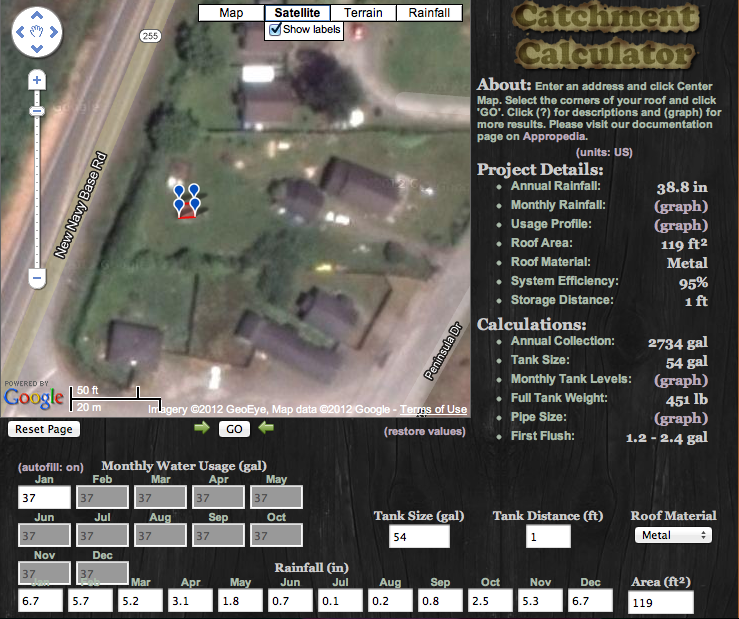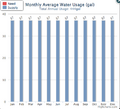
The global population has reached 7 billion people and continues to grow steadily. With the huge growth in our population, human beings have become more aware of the value of our limited resources. Many people are looking towards ways of sustainable living and preserving natural resources in order to survive in this rapidly growing population. One of the more abundant natural resource in Humboldt County is rainwater. This ecological awareness and the search for sustainability has lead me to designing a small rainwater catchment system for my greenhouse. Rainwater harvesting or collecting refers to the collection and storage of rainwater. Rainwater is usually collected from rooftops and diverted into a storage tank for later usage that includes but am not limited to watering gardens and landscaping, washing cars, washing laundry to flushing toilets.
Background[edit | edit source]
I have always been interested in off grid living while trying to maintain a sustainable lifestyle. We have implemented some of these ideas in the 2 years we have lived here; ranging from raising hens for eggs, organic gardening to composting. We have also built a greenhouse using salvaged windows, doors and various recycled building materials. The greenhouse is located in our backyard in Manila, CA. The greenhouse rainwater catchment system seems to be a natural next step toward self-sufficiency and natural resource preservation. We decided that utilizing the knowledge and information gained from the spring 2012 Engineering 305 projects would be the perfect momentum we needed to implement this system. This project will begin in January 2012 and will be completed in May 2012.

Opportunity Statement[edit | edit source]
The objective of this project is to install a small rainwater catchment system in the 10x12 greenhouse my husband and I have built in our backyard, which is located in Manila, CA. We hope to use as much recycled and salvaged building material as we possibly can with this project. The green house is used for sprouting seeds in the spring since we can experience freezing weather and hail storms even in the spring time. Most of the water used in the green house is for watering seedlings and starts before they are transported outside into the garden in our backyard.
Criteria
| Criteria | Constraint | Weight |
|---|---|---|
| System Efficiency | The installed system catches 80% of rainfall runoff from the greenhouse. | 10 |
| Budget | Less than $200. | 9 |
| Maintenance | Less than 1 hour of work per week. | 8 |
| Functionality | They system has to work and be able to pump and transport water into greenhouse and garden and for irrigation use. | 8 |
| Educational | The system will serve as a small-scale example of rainwater harvesting. | 7 |
| Durability | Lifespan of system = At least 5 years. | 6 |
| Appropriate Use of Material | To use as much recycled or salvaged material as possible in building this system. | 5 |
| Water Potability | Clean and sanitary enough for irrigation use. | 5 |
Materials
| Quantity | Material | Source | Cost ($) | Total ($) |
|---|---|---|---|---|
| 1 | 55 Gallon Water Storage Tank | Craigslist | 40 Each | 40.00 |
| 1 | 12 ft Rain Gutter | Pierson's Hardware | 1 Foot | 12.00 |
| 1 | Rain Gutter T Gutter | Pierson's Hardware | 8 Each | 8.00 |
| 1 | Rain Gutter End Cap | Pierson's Hardware | 8 Each | 8.00 |
| 5 | Rain Gutter Bracket | Pierson's Hardware | 3 Each | 15.00 |
| 20 | Screws and Nails | Pierson's Hardware | 10 Each | 10.00 |
| 1 | 12 ft Down Spout | Pierson's Hardware | 1 Foot | 12.00 |
| 1 | 8 ft hose | Pierson's Hardware | 1 Foot | 8.00 |
| 1 | Poly Body/ Washer Union | Pierson's Hardware | 10 Each | 10.00 |
| 1 | Spiket | Piersons Hardware | 10.00 | 10.00 |
| Total Cost | $133.00 | |||
Rainwater Catchment basics[edit | edit source]
The purpose of a rainwater catchment is to collect rainwater and store it for later use. Using rainwater for watering the garden will save clean potable water from being wasted when resources such as rain water are available for free. To maximize the amount of rain captured, there are many variables to consider. The ideal surface to collect rainwater is a metal roof, however nearly any roof can serve as a collection surface. The square footage of the catchment surface is only as big as the foot print of your house, garage or (in my case) the green house. Although the surface area of a sloped roof is greater that the foot print of the house, the amount of rain that falls on the foot is not affected by the slope. Water that is one inch deep and one foot square equals exactly.6233 gallons. However, we subtract approximately 20% which is lost due to evaporation, leaks, plugged gutters, etc. So the number is rounded down. In a one inch rain you can catch approximately 550 gallons per 1000 square feet of collection surface. You can calculate the amount of rain you can catch by using a simple calculation by dividing the square feet of the total catchment area by 1000 and multiply that number by 550 to determine gallons collected per one inch of rain. Multiply that by the average annual rainfall in your area and you will the the amount of water you could collect.[1]

Rainwater Catchment Concerns[edit | edit source]
Concerns regarding rainwater catchment systems deal with a wide variety of issues ranging from the location of the water storage tank to the collection and filtration process. This books covers various concern from rain collection in dry lands to landscaping with the goal of maximizing rain collection.[2]
Peer Reviewed Article
Indirect lack of water can be defined as the case where water-resources are sufficient to meet anthropogenic demands, but available water resources may be allocated for other uses or the resources can be undesirable for political reasons. Such indirect deficit occurs because water is needed to sustain ecosystems or because the water supply is based on politically undesirable water imports.[3]
Several literature suggested that I follow a thought-out plan when building a rain catchment system. The planning process begins with a long and thoughtful observation and begin the project at the top or the high point of the watershed and work my way down. It also suggested that I start small and simple. Planning for an overflow is a must in building rainwater collection as well as a continuous reassessment of the system.[4]
-
Chart of monthly average rainfall in Manila, CA found on http://www.pequals.com/rain/
-
Chart of the average water usage in the green house screen shot from http://www.pequals.com/rain/
-
Chart of the estimated end of the month water storage tank level- screen shot from http://www.pequals.com/rain/
-
Chart of the estimated maximum flow through the downspout.http://www.pequals.com/rain/
These are some web sites I fund that contained useful information regarding rainwater collection:
- Rainwater Catchment Calculator
- Rainwater Collection & Harvesting Systems
- Rain Barrel Guide
- Harvest H2O
Proposed Timeline[edit | edit source]
| Task | Description | Proposed Date | Actual Date |
|---|---|---|---|
| Literature Review | Review relevant literature | 2-13-12 | 2-13-12 |
| Measure Greenhouse | Take necessary measurements of the green house for installation of rain gutter and down spout |
3-3- 12 | 3-14-12 |
| Present Project Plan to Client (Husband) | Allocate the materials we can reuse for this project | 3-3-12 | 3-15-1 |
| Purchase Material | Purchasing various material that we can not salvage | 3-18-12 | 4-20-12 |
| Begin Building | Build rainwater catchment system and foundation for the water storage tank | 3-11-12 | 4-20-12 |
| Testing Installed System | Make any necessary adjustment to the system | 3-25-12 | 4-26-12 |
| Rainwater Catchment System Maintenance | Check filter and first flush to make sure it is working properly | 4-19-12 | 5-7-12 |
| Project Analysis | Complete analysis of success/failures of project | 4-30-12 | 5-7-12 |
Design[edit | edit source]
Below are pictures of the green house where we plan to install the rainwater catchment system. The majority of the materials used in the green house is from salvaged and recycled windows and doors. This green house has a foot print of 10ftx12ft. This is the maximum space we could build a structure with out paying for a county permit to build.
-
Rainwater catchment site
-
Rainwater catchment side view
-
Rainwater catchment side view 2
Building the System[edit | edit source]
-
We used a 1" drill bit to drill a hole into the water storage tank to install a spigot.
-
Installing the mounting hardware for the spigot to prevent leaks and easy future maintenance
-
The spigot is installed on the rainwater storage tank
Installing the First Flush System[edit | edit source]
-
This was an old electrical box on our house. The pipe diameter was perfect for the racquetball as a first flush diverter.
-
This is what the ball valve looks like on the inside.
-
Lets see if it floats!
-
Giving the first flush ball valve a test run before mounting it on the green house.
-
Yes! It floats and diverts water out and away from the first flush bucket!
Installing the Large Debris Filter[edit | edit source]
-
Cutting a pipe at 60 degrees is tricky work. We found a PVC pipe that was left in our garage so we decided to repurpose it as our large debris filter. It took a few measurements to make sure the slope was 60 degrees.
-
We repurposed an old chicken coop wire and are cutting it up for a large debris filter. The 60 degrees angle allows the flow of the water from the gutter to wash off any large old debris that may have collected while trapping new ones.
-
We thought this would last longer than zip ties.
-
Using silicon to seal the first flush ball valve.
-
Next, we use more silicon to seal the large debris filter.
-
Here we are mounting a milk crate onto the greenhouse to hold the first flush storage and the large debris filter.
Rainwater Catchment Finished Project[edit | edit source]
-
This is the finished rainwater catchment system that was installed in Manila, CA.
-
The large debris filter appears to be filtering out the large debris.
-
Here is a close up of the first flush and large debris catchment system.
-
Here is a view of the installed rainwater catchment system from the front of the greenhouse.
Literature Review[edit | edit source]
This is a review of the available literature pertinent to building a rainwater catchment system.
References[edit | edit source]
- ↑ Banks, Suzy, and Richard Heinichen. Rainwater collection for the mechanically challenged. 2nd rev. ed. Dripping Springs, Tex.: Tank Town Pub., 2004.
- ↑ Lancaster, Brad, and Joe Marshall. Rainwater harvesting for drylands. Tucson, AZ: Rainsource Press, 2006.
- ↑ 2011. Increasing Urban Water Self-sufficiency: New Era, New Challenges. Journal of Environmental Management. 92, no. 1: 185.
- ↑ Pacey, Arnold, and Adrian Cullis. 1986. Rainwater Harvesting: The Collection of Rainfall and Run-off in Rural Areas. London: Intermediate Technology Publications.






















